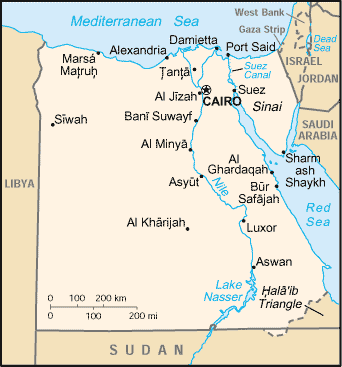Geography of Egypt
|
|
Nile_River_and_delta_from_orbit.jpg
Location: Most of Egypt is in North Africa; the Sinai Peninsula is in Southwest Asia. The country has shorelines on the Mediterranean Sea and the Red Sea; it borders Libya to the west, Sudan to the south, and the Gaza Strip and Israel to the east.
Geographic coordinates: Template:Coor dm)
Map references: Africa
Area:
total:
1,001,450 km²
land:
995,450 km²
water:
6,000 km²
Area - comparative: slightly more than three times the size of New Mexico (US)
Land boundaries:
total:
2,689 km
border countries:
Gaza Strip 11 km, Israel 255 km, Libya 1,150 km, Sudan 1,273 km
Coastline: 2,450 km
Maritime claims:
contiguous zone: 24 nm
continental shelf: 200-m depth or to the depth of exploitation
exclusive economic zone: 200 nm
territorial sea: 12 nm
Climate: desert; hot, dry summers with moderate winters
Terrain: vast desert plateau interrupted by Nile valley and delta
Elevation extremes:
lowest point: Qattara Depression -133 m
highest point: Mount Catherine 2,629 m
Natural resources: petroleum, natural gas, iron ore, phosphates, manganese, limestone, gypsum, talc, asbestos, lead, zinc
Land use:
arable land:
2%
permanent crops:
0%
permanent pastures:
0%
forests and woodland:
0%
other:
98% (1993 est.)
Irrigated land: 32,460 km² (1993 est.)
Natural hazards: periodic droughts; frequent earthquakes, flash floods, landslides, volcanic activity; hot, driving windstorm called khamsin occurs in spring; dust storms, sandstorms
Environment - current issues: agricultural land being lost to urbanization and windblown sands; increasing soil salination below Aswan High Dam; desertification; oil pollution threatening coral reefs, beaches, and marine habitats; other water pollution from agricultural pesticides, raw sewage, and industrial effluents; very limited natural fresh water resources away from the Nile which is the only perennial water source; rapid growth in population overstraining natural resources
Environment - international agreements:
party to:
Biodiversity, Climate Change, Desertification, Endangered Species, Environmental Modification, Hazardous Wastes, Law of the Sea, Marine Dumping, Nuclear Test Ban, Ozone Layer Protection, Ship Pollution, Tropical Timber 83, Tropical Timber 94, Wetlands, Whaling
signed, but not ratified:
Climate Change-Kyoto Protocol
Geography - note: controls Sinai Peninsula, only land bridge between Africa and remainder of Eastern Hemisphere; controls Suez Canal, shortest sea link between Indian Ocean and Mediterranean Sea; size, and juxtaposition to Israel, establish its major role in Middle Eastern geopolitics
External link
- Map (http://www.lib.utexas.edu/maps/africa/egypt_pol97.jpg)fr:Géographie de l'Égypte

